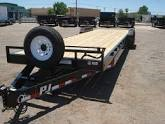Recently, a vehicle towing a trailer lost control on Highway 270 in west St. Louis County. The out of control vehicle weaved through several lanes of traffic causing a fiery, chain reaction four-car pile-up that left one person dead and two others seriously injured.
While it is not immediately clear what caused the accident, the Missouri State Highway Patrol is pointing toward the tow vehicle and its erratic moments just prior to the accident as the probable cause.
Towing a vehicle makes for tricky driving under the best conditions. But throw in inclement weather, driving distractions, drowsy drivers, or excessive speed – and you’ve got a potentially deadly disaster. If you are going to tow a trailer of any kind, the National Highway Transportation Safety Administration offers these tips to help you and your cargo arrive safely:
A few things to note before towing a trailer…
First, it is highly recommended that a driver take time to practice driving the tow vehicle and the trailer before embarking on main roads. Secondly, never allow a person to ride in or on the trailer while it is under tow.
General Handling
- Use the driving gear that the manufacturer recommends for towing.
- Drive at moderate speeds. This will place less strain on your tow vehicle and trailer. Trailer instability (sway) is more likely to occur as speed increases.
- Avoid sudden stops and starts that can cause skidding, sliding, or jackknifing.
- Avoid sudden steering maneuvers that might create sway or undue side force on the trailer.
- Slow down when traveling over bumpy roads, railroad crossings, and ditches.
- Make wider turns at curves and corners. Because your trailer’s wheels are closer to the inside of a turn than the wheels of your tow vehicle, they are more likely to hit or ride up over curbs.
- To control swaying caused by air pressure changes and wind buffeting when larger vehicles pass from either direction, release the accelerator pedal to slow down and keep a firm grip on the steering wheel.
Braking
- Allow considerably more distance for stopping.
- If you have an electric trailer brake controller and excessive sway occurs, activate the trailer brake controller by hand. Do not attempt to control trailer sway by applying the tow vehicle brakes; this will generally make the sway worse.
- Always anticipate the need to slow down. To reduce speed, shift to a lower gear and press the brakes lightly.
Acceleration and Passing
- When passing a slower vehicle or changing lanes, signal well in advance and make sure you allow extra distance to clear the vehicle before you pull back into the lane.
- Pass on level terrain with plenty of clearance. Avoid passing on steep upgrades or downgrades.
- If necessary, downshift for improved acceleration or speed maintenance.
- When passing on narrow roads, be careful not to go onto a soft shoulder. This could cause your trailer to jackknife or go out of control.
Downgrades and Upgrades
- Downshift to assist with braking on downgrades and to add power for climbing hills.
- On long downgrades, apply brakes at intervals to keep speed in check. Never leave brakes on for extended periods of time or they may overheat.
- Some tow vehicles have specifically calibrated transmission tow-modes. Be sure to use the tow-mode recommended by the manufacturer.
Backing Up
- Put your hand at the bottom of the steering wheel. To turn left, move your hand left. To turn right, move your hand right. Back up slowly. Because mirrors cannot provide all the visibility you may need when backing up, have someone outside at the rear of the trailer to guide you, if possible.
- Use slight movements of the steering wheel to adjust direction. Exaggerated movements will cause greater movement of the trailer. If you have difficulty, pull forward and realign the tow vehicle and trailer and start again.
Parking
- Try to avoid parking on grades. If possible, have someone outside to guide you as you park. Once stopped, but before shifting into Park, have someone place blocks on the downhill side of the trailer wheels. Apply the parking brake, shift into Park, and then remove your foot from the brake pedal. Following this parking sequence is important to make sure your vehicle does not become locked in Park because of extra load on the transmission. For manual transmissions, apply the parking brake and then turn the vehicle off in either first or reverse gear.
- When uncoupling a trailer, place blocks at the front and rear of the trailer tires to ensure that the trailer does not roll away when the coupling is released.
- An unbalanced load may cause the tongue to suddenly rotate upward; therefore, before un-coupling, place jack stands under the rear of the trailer to prevent injury.
Matt Casey and Matt Devoti are partners with Casey & Devoti, a St. Louis-based personal injury law firm. Together, they have over 40 years of experience handling a wide variety of personal injury cases, including: automobile, truck and train accidents, medical malpractice, product and premises liability, elder care and sexual abuse, Workers’ Compensation, and wrongful death. If you have been injured by the negligence of another, you may be entitled to compensation for things like medical expenses, lost wages, pain, and suffering. Matt and Matt are happy to meet with you for a free, no-obligation consultation to review the specific circumstances of your injury.
Call or email today: (314) 421-0763 or info@caseydevoti.com








